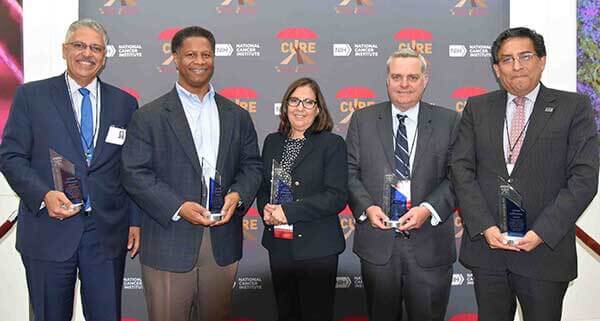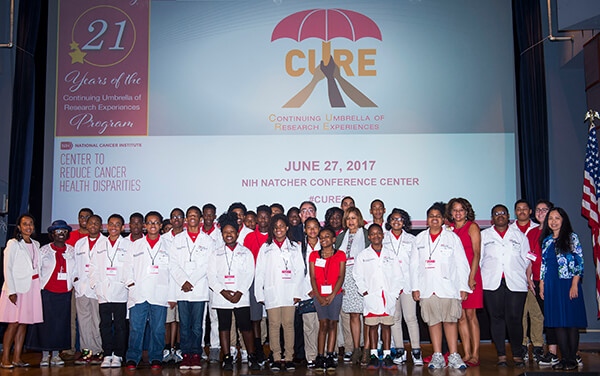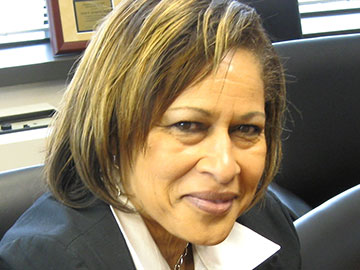
NCI's CURE Program—21 Years of Increasing Diversity in the Biomedical Workforce
July 10, 2017, by Sanya A. Springfield, Ph.D.
“CURE was a huge stepping stone for me. It opened up a vast number of doors.”
—Former CURE scholar, Elva Arredondo, Ph.D.
Over the past several decades, the ethnic and racial makeup of our country’s population has become increasingly diverse. African Americans, Hispanic Americans, and Asian Americans now represent a far larger segment of the overall population than they once did, and that trend is expected to continue into the future.
But even as our nation has grown increasingly diverse, the number of minorities among our biomedical research ranks has not grown proportionately: less than 11% of the US research community are members of underrepresented groups, which also include American Indians, Alaska Natives, and Native Hawaiians and other Pacific Islanders.
It’s this underrepresentation that NCI’s Center to Reduce Cancer Health Disparities(CRCHD) Continuing Umbrella of Research Experiences (CURE) training program was designed to change when it was launched just over two decades ago. The CURE program has a holistic, national research training and career development strategy and philosophy. This approach is meant to address the lack of opportunity, resources, and support that members of racial and ethnic minority groups—as well as individuals with disabilities or from underserved backgrounds—often experience and that makes it difficult for them to become cancer researchers.
With CURE now in its 21st year, last month we proudly hosted “Celebrating 21 Years of the CURE Program” to recognize the program’s significant strides. Supporting more than 3,000 scholars at almost every point in the research training continuum and in almost every state across the country, CURE is helping to build the diverse workforce we need for the future.
Although researchers from minority backgrounds can and should be able to take part in all areas of cancer research, minority researchers are in a special position to be able to make vital contributions to understanding and reducing cancer health disparities. Individuals from underserved racial and ethnic communities often, due to inherent mistrust and misinformation about medical research, do not go for regular screenings or participate in clinical trials. When physicians, researchers, and health care professionals from diverse racial and ethnic populations provide care and participate in public education and outreach programs, it helps to build trust, increases uptake of preventive behaviors, and expands participation in clinical trials.
NCI’s Commitment to Workforce Diversity
Despite years of awarding only diversity supplements, in the mid-1990s, NCI recognized the need to make a more concerted effort to build diversity in the cancer research workforce.
Our challenge was shaping research training and career development opportunities that could address multiple goals. These included ensuring that the cancer researchers of the future reflect the nation’s demographic heterogeneity, have the skills and experiences to compete successfully for limited research resources, gain the experience and reputation to be selected as participants on scientific review boards, and are fully prepared to face the challenges of a research career.
So, in 1996, NCI initiated a diversity training program, and the following year developed the first Mentored Research Scientist Development Award to Promote Diversity (K01). This latter award was designed to promote career development and mentored training experiences in cancer research to individuals from underrepresented groups.
From here, a series of mentored career development awards were developed and implemented, and with the expansion of CRCHD in 2007, CURE became CRCHD’s signature training program.
The Key to CURE’s Success
We designed CURE to provide biomedical research training across the span of an individual’s career, starting as early as middle school and continuing through to early-stage independent research.
The key to CURE’s approach is that it seamlessly links a variety of NCI funding mechanisms—both existing and new—established to address gaps at important career transition points where individuals have tended to drop out of the research track. This approach has been enormously successful: 98% of CURE predoctoral scholars are completing or have completed doctoral degrees.
An important element in CURE’s success is its emphasis on mentorship. Many CURE scholars tell us that never in their wildest dreams had they imagined they could pursue a research career until they met mentors who looked like them—had the same skin color and came from similar cultural and economic backgrounds. Such mentors can serve as powerful motivators for individuals from underrepresented populations.
The program links each scholar with a supportive academic mentor: a role model who can bridge cultural perspectives and demonstrate not just the possibility, but also the reality, of success in a research career. CURE was the first NIH program to support this type of mentorship.
Another hallmark of CURE is the protected time that scholars are ensured, enabling them to focus solely on research without the pressure of also having to teach or provide clinical care.
The program has recently fully incorporated training navigation as an element to enhance scholars’ chances of carving out a successful research trajectory. Working together as a team, CURE program directors and training navigator assist and support current and prospective CURE scholars, facilitating their entry into the CURE program, assisting with transitions to their next independent award, and recommending additional training opportunities and resources to help develop the skills required to obtain research grants.
Until recently, CURE began at the high school level. Yet, research has shown that it is important to reach students at an even earlier stage, before they make choices that limit their academic and career options.
As a result, we’ve expanded CURE to reach younger students, and we now are providing funding support for a first-of-its-kind biomedical research training and career development program model for middle school students from underrepresented populations. The program—a partnership between the University of Maryland, Baltimore, and the University of Maryland Marlene and Stewart Greenebaum Comprehensive Cancer Center—works with three middle schools in West Baltimore to offer weekly mentoring and tutoring to 65 sixth- and seventh-grade students who are growing up in impoverished and vulnerable situations.
The program is already demonstrating success in generating excitement about science and medicine among these children. It’s wonderful to hear these 11-year-olds—some of whom began the program aspiring to become hairdressers, professional athletes, and musicians—now proudly voicing their plans to pursue careers in which they hope to cure cancer.
21 Years of Building Diversity
At last month’s celebration, CRCHD recognized an exemplary group of 26 current and former CURE scholars and some of the mentors and champions who have been vital to CURE’s success. We also kicked off the CURE Distinguished Scholars Seminar series, which features exceptional former CURE scholars who have advanced cancer research and become role models for other scientists from underrepresented backgrounds.
Despite the extraordinary growth and success of CURE over the past two decades, our efforts are not concluded. Disparities in cancer incidence and outcomes persist in underserved populations, as does underrepresentation in the numbers and successes of researchers from diverse populations. Only through focused attention and galvanized commitment to these issues will we see greater change.
It is my hope that CURE provides a blueprint for the broader biomedical research community to develop similar programs. The ultimate success of CURE and programs like it will be achieved when diversity in the research workforce and disparities in our population groups are no longer issues. And with the addition of each new CURE scholar, we are one step closer to that future.
























.jpg)












No hay comentarios:
Publicar un comentario